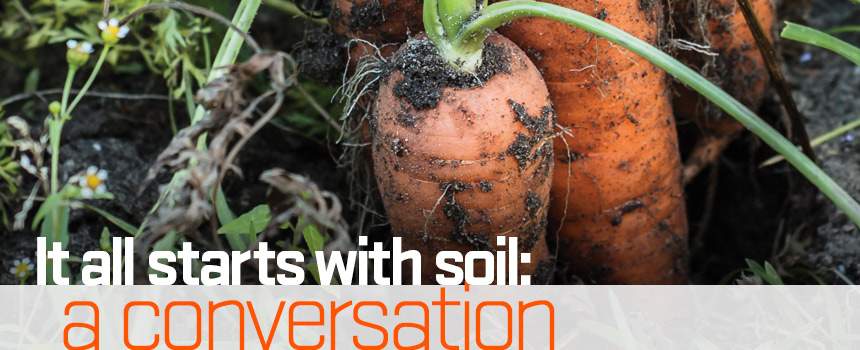It All Starts with Soil: A Conversation

Why open the “food and beverage issue” of Oregon’s Agricultural Progress magazine with a conversation about soil? Because food starts with soil. In fact, we’d be hard pressed to have any agricultural progress without soil. So, in homage to the treasures beneath our feet, we’ve invited three scientists from OSU’s Department of Crop and Soil Science to help explain the fundamental connection between our food and the soil that feeds our food. Let me introduce Jay Noller, soil geomorphologist; Jennifer Parke, soil microbiologist; and James Cassidy, soil science instructor.
Q. Why should people who eat care about soil?
JC: People can’t photosynthesize. We’re dependent on organisms that can in order to get the energy and nutrients we need to survive. Most of the organisms that we eat depend on soil, along with air, sunshine, and water, to make the energy and nutrients that they need to survive.
JP: Plants feed us, and there’s a universe of soil microorganisms that feed plants. New discoveries are being made every day about the importance of soil microbes to plant growth and the information that is exchanged at the molecular level. We’re now able to study soil microbes where they live in soil, not just the few that we can grow in petri dishes. And we’re finding that soil around the growing roots of plants is teeming with life, with billions of microbes that are competing, feeding, suppressing, stimulating, communicating, and consuming each other. Many of these soil microorganisms protect plants against threats and provide plants with the nutrients they need to grow. And many of those protections and nutrients are passed on to us when we eat those plants.
JN: At the same time we’re exploring the microbiome inside our own bodies, soil scientists are exploring the soil microbiome, particularly at the root zone of food plants. The same genetic technologies used to map the human microbiome now make it possible for us to explore the connection between soil-borne microorganisms and our own human health and digestion.
JP: Eighty percent of antibiotics currently in clinical use have been derived from soil bacteria and fungi. And when you consider all the ecosystem services we get from soil—nutrient cycling, water quality, food and wood production, carbon sequestration—it seems obvious that the thing that’s made it possible is this living soil.
Q. Switching focus from global to local, what is terroir?
JN: In French, “terroir” means “related to the land or a place on earth.” As a soil scientist, I think of soil as a natural resource. It’s related to its parent minerals; to the climate, sunlight, and water that affects its biochemistry; and to the complex physical landscape that influences its biota. Although we have yet to be able to conduct experiments that control for all these variables, there have been several studies of sensory science at Oregon State that confirm that a plant and its characteristic products are directly related to the soil in which it grow
JC: Soil is not a single variable, however. Many things can contribute to the taste and quality of food crops. But when a landscape is revered for the taste and quality of the food it produces, it’s often reason enough to protect that landscape, to sustain it.
Q. Where does soil come from?
JN: Every atom in your body has its origin as stardust. Remnants from exploded stars and galaxies continue to rain down on earth, carrying oxygen, carbon, iron, and other elements. We are the result of a process that turns stardust into nutrients essential for life. Soil is a fundamental part of that process.
JC: In many ways, soil created civilized society. Much of our civilized culture is a direct outgrowth of agri-culture. Before agriculture, we followed herds and gathered plants through the seasons. Growing food on soil settled people and rooted them into communities where music, arts, and sciences flourished.
Q. What is the future of soil?
JN: Soil is a finite natural resource. It takes hundreds of thousands of years, or more, to grind rock into soil minerals, then transport that material downstream, sort deposits of cobbles and finer sediments, and undergo biochemical changes at all stages. The ancient Egyptians grew their crops on relatively young soils deposited each year by Nile floods. However, those soils were formed by physical and biochemical effects far upstream and continued all along the journey.
JP: We’re spoiled in the United States by having an abundance of good soil. That’s not true everywhere. In some parts of the world, deforestation and land conversion have interfered with nutrient cycling. That’s where we see lots of soil carbon released into the atmosphere as CO2, and the soil microbiome—the life of the soil, and the nutrients—are depleted.
JC: Here, in Oregon, we live in the luxury of soil: a beautiful, living thing that is essential for life.

